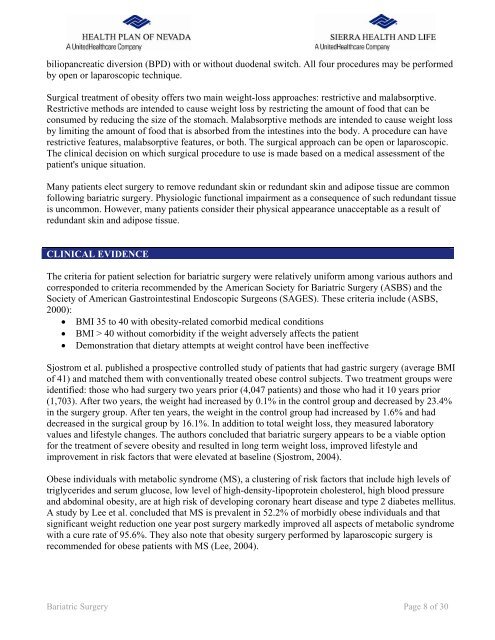BARIATRIC SURGERY - Health Plan of Nevada
BARIATRIC SURGERY - Health Plan of Nevada
BARIATRIC SURGERY - Health Plan of Nevada
Create successful ePaper yourself
Turn your PDF publications into a flip-book with our unique Google optimized e-Paper software.
WOU001<br />
biliopancreatic diversion (BPD) with or without duodenal switch. All four procedures may be performed<br />
by open or laparoscopic technique.<br />
Surgical treatment <strong>of</strong> obesity <strong>of</strong>fers two main weight-loss approaches: restrictive and malabsorptive.<br />
Restrictive methods are intended to cause weight loss by restricting the amount <strong>of</strong> food that can be<br />
consumed by reducing the size <strong>of</strong> the stomach. Malabsorptive methods are intended to cause weight loss<br />
by limiting the amount <strong>of</strong> food that is absorbed from the intestines into the body. A procedure can have<br />
restrictive features, malabsorptive features, or both. The surgical approach can be open or laparoscopic.<br />
The clinical decision on which surgical procedure to use is made based on a medical assessment <strong>of</strong> the<br />
patient's unique situation.<br />
Many patients elect surgery to remove redundant skin or redundant skin and adipose tissue are common<br />
following bariatric surgery. Physiologic functional impairment as a consequence <strong>of</strong> such redundant tissue<br />
is uncommon. However, many patients consider their physical appearance unacceptable as a result <strong>of</strong><br />
redundant skin and adipose tissue.<br />
CLINICAL EVIDENCE<br />
The criteria for patient selection for bariatric surgery were relatively uniform among various authors and<br />
corresponded to criteria recommended by the American Society for Bariatric Surgery (ASBS) and the<br />
Society <strong>of</strong> American Gastrointestinal Endoscopic Surgeons (SAGES). These criteria include (ASBS,<br />
2000):<br />
• BMI 35 to 40 with obesity-related comorbid medical conditions<br />
• BMI > 40 without comorbidity if the weight adversely affects the patient<br />
• Demonstration that dietary attempts at weight control have been ineffective<br />
Sjostrom et al. published a prospective controlled study <strong>of</strong> patients that had gastric surgery (average BMI<br />
<strong>of</strong> 41) and matched them with conventionally treated obese control subjects. Two treatment groups were<br />
identified: those who had surgery two years prior (4,047 patients) and those who had it 10 years prior<br />
(1,703). After two years, the weight had increased by 0.1% in the control group and decreased by 23.4%<br />
in the surgery group. After ten years, the weight in the control group had increased by 1.6% and had<br />
decreased in the surgical group by 16.1%. In addition to total weight loss, they measured laboratory<br />
values and lifestyle changes. The authors concluded that bariatric surgery appears to be a viable option<br />
for the treatment <strong>of</strong> severe obesity and resulted in long term weight loss, improved lifestyle and<br />
improvement in risk factors that were elevated at baseline (Sjostrom, 2004).<br />
Obese individuals with metabolic syndrome (MS), a clustering <strong>of</strong> risk factors that include high levels <strong>of</strong><br />
triglycerides and serum glucose, low level <strong>of</strong> high-density-lipoprotein cholesterol, high blood pressure<br />
and abdominal obesity, are at high risk <strong>of</strong> developing coronary heart disease and type 2 diabetes mellitus.<br />
A study by Lee et al. concluded that MS is prevalent in 52.2% <strong>of</strong> morbidly obese individuals and that<br />
significant weight reduction one year post surgery markedly improved all aspects <strong>of</strong> metabolic syndrome<br />
with a cure rate <strong>of</strong> 95.6%. They also note that obesity surgery performed by laparoscopic surgery is<br />
recommended for obese patients with MS (Lee, 2004).<br />
Bariatric Surgery Page 8 <strong>of</strong> 30

















